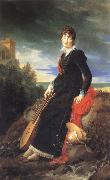All Francois Gerard's oil paintings


|
|
|
| ID |
Image |
Oil Pantings, Sorted from A to Z |
Other Information |
| 83748 |
 |
Daphnis and Chloe |
"Daphnis and Chloe" by François Gxrard, circa 1824, oil on canvas, Detroit Institute tof Arts
cjr |
| 96076 |
 |
Holy Family with St Bruno and St Helena |
1626(1626)
Medium oil on canvas
cyf |
| 95502 |
 |
Jacques Alexandre Bernard Law |
Jacques Alexandre Bernard Law
cyf |
| 33854 |
 |
Madame Recamier |
mk87
1805
Oil on canvas
225x145cm
Paris,Musee Carnavalet
|
| 21305 |
 |
Madame Recamier (mk09) |
1805
Oil on cavnas 225 x 145 cm
Paris,Musee Carnavalet |
| 22817 |
 |
Madame Recamier (mk22) |
1802
Oil on canvas,225 x 145 cm
Paris,Musee Carnavalet |
| 22818 |
 |
Ossian on the Bank of the Lora,Invoking the Gods to the Strains of a Harp (mk22) |
undated
Oil on canvas,184.5 x 194.5 cm
Hamburg,Hamburger Kunsthalle |
| 80902 |
 |
Portrait of Caroline Murat descending the staircase of Elysee Palace |
1810
Oil on canvas
0.32 x 0.23 m (0.3 x 0.3 yd)
cyf |
| 41074 |
 |
Portrait of Josephine |
mk159
1801
Oil on canvas
178x174cm
|
| 40642 |
 |
Portrait of Katarzyna Starzenska |
mk156
c.1803
Oil on canvas
215x130.5cm
|
| 30669 |
 |
Portrait of Napoleon Bonaparte |
mk68
Oil on canvas
Capidomonte
Museum
1807
France
|
| 32589 |
 |
Recreation by our Gallery |
mk79
|
| 79634 |
 |
Retrato de Carlos X de Francia en traje de coronacion |
1825(1825)
Medium Oil on canvas
Dimensions 259 x 183 cm (102 x 72 in)
cyf |
| 30658 |
 |
The Happiness of Being a Mother |
mk68
Oil on canvas
Sint Petersburg,State Hermitage Museum.
c.1799
France
|
|
|
| Francois Gerard
|
| French Neoclassical Painter, 1770-1837
was a French painter born in Rome, where his father occupied a post in the house of the French ambassador. His mother was Italian. François Gerard was born in Rome, on 12 March 1770, to J. S. Gerard and Cleria Matteï. At the age of twelve Gerard obtained admission into the Pension du Roi in Paris. From the Pension he passed to the studio of the sculptor Augustin Pajou which he left at the end of two years for that of the history painter Nicolas-Guy Brenet, whom he quit almost immediately to place himself under Jacques-Louis David. In 1789 he competed for the Prix de Rome, which was carried off by his comrade Girodet. In the following year (1790) he again presented himself, but the death of his father prevented the completion of his work, and obliged him to accompany his mother to Rome. In 1791 he returned to Paris; but his poverty was so great that he was forced to forgo his studies in favor of employment which should bring in immediate profit. David at once availed himself of his help, and one of that master's most celebrated portraits, of Le Pelletier de St Fargeaumay, owes much to the hand of Gerard. This painting was executed early in 1793, the year in which Gerard, at the request of David, was named a member of the revolutionary tribunal, from the fatal decisions of which he, however, invariably absented himself. In 1794 he obtained the first prize in a competition, the subject of which was The Tenth of August, and, further stimulated by the successes of his rival and friend Girodet in the Salons of 1793 and 1794, Gerard (nobly aided by Jean-Baptiste Isabey, the miniaturist, produced in 1795 his famous Belisaire. In 1796 a portrait of his generous friend (in the Louvre) obtained undisputed success, and the money received from Isabey for these two works enabled Gerard to execute in 1797 his Psyche et l'Amour (illustration). At last, in 1799, his portrait of Madame Mere established his position as one of the first portrait-painters of the day. In 1808 as many as eight, in 1810 no less than fourteen portraits by him, were exhibited at the Salon, and these figures afford only an indication of the enormous numbers which he executed yearly; all the leading figures of the Empire and of the Restoration, all the most celebrated men and women of Europe, sat to Gerard. This extraordinary vogue was due partly to the charm of his manner and conversation, for his salon was as much frequented as his studio; Madame de Staël, George Canning, Talleyrand, the Duke of Wellington, have all borne witness to the attraction of his society. Rich and famous, Gerard was stung by remorse for earlier ambitions abandoned; at intervals he had indeed striven to prove his strength with Girodet and other rivals, and his Bataille d'Austerlitz (1810) showed a breadth of invention and style which are even more conspicuous in L'Entree d'Henri IV Paris (at Versailles), the work with which in 1817 he did homage to the Bourbons. After this date Gerard declined,
. Related Artists to : | Laurens Craen | Francesco Cozza | Hugh Bolton Jones | Monedero, Angel Lizcano | Alfred Chataud | |

|
|

|
|